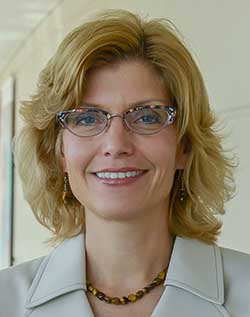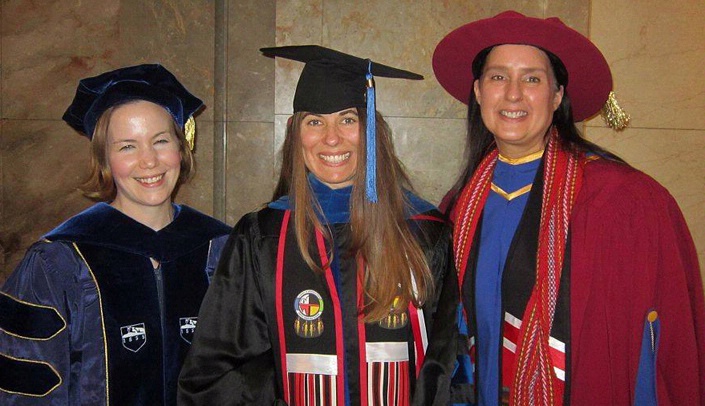Regina Robbins, Ph.D., came to UNMC with a bachelors in psychology, a master’s in Christian spirituality and a master’s in Spanish language. She was planning to study yoga, spirituality and wellness.
By the time she left with her Ph.D., she had:
- discovered the meaning and importance of public health.
- gained deep appreciation for and practice in community-based participatory research.
- participated in an NIH funded youth advocacy childhood-obesity prevention program in South Omaha.
- worked under the supervision of Lisa St. Clair, Ed.D., at the Munroe-Meyer Institute as a graduate research assistant, where she learned an “extraordinary amount” about program evaluation and working with diverse communities.
- taken classes under the tutelage of Michele Desmarais, Ph.D., at the University of Nebraska at Omaha in the Religious Studies and Native American Studies departments.
- written, for her comprehensive exam, a spec grant proposal that prepared her for writing a recent Department of Education grant that was funded at $400,000 a year for up to four years to prepare American Indian educators to serve in public schools.
- developed and implemented a campus-based spiritual wellness initiative at UNO.
Today, she is the program developer of the P’oe Pathways program at Northern New Mexico University, running a project that provides American Indian students with funding and support services to earn a degree or endorsement from NNMC’s College of Education.
The P’oe program will develop culturally relevant health education and early childhood education programs and provide the eight Northern pueblos and Northern New Mexico school districts with outreach services and professional development.
“Honestly, I didn’t know where I wanted to go,” said Dr. Robbins, who now has a faculty position at the university. “My advisor, Dr. Tibbits, kept asking me what kind of career I wanted. I could not give her a solid answer, but the freedom I had to explore career possibilities within the MSIA program helped me grow into myself and find my wild way.”
The Medical Sciences Interdepartmental Area (MSIA) program, is one of the largest programs on campus. The program allows students such as Dr. Robbins to combine different disciplines, creating a flexibility of study that enables a student to mine areas of personal interest and accommodate an evolution in research interests and career goals.
 |
Laura Bilek, Ph.D. |
In Dr. Robbins’ case, the program allowed her to tailor her program to best suit her maturing academic interests.
“I was introduced to different fields of study and career opportunities that I wasn’t even aware of before,” she said. “The combination of my research assistantship and UNO courses gave me a better understanding of what it means to be a Native Scholar and how to work effectively with diverse communities; the UNMC College of Public Health really gave me the research methods and tools to do so; and Dr. Bilek’s leadership and guidance encouraged me to embrace opportunities for growth and keep calm and carry on.”
Dr. Robbins said, “Dr. Bilek created a home for MSIA students.” Indeed, the feeling of community is part of the strength of the MSIA program, even though students come from varied backgrounds and are pursuing widely differing courses of study.
“In physical therapy alone, for example, the first two Ph. D. candidates have very different focus in their program — biomechanical changes in osteoarthritis of the knee, and exercise immunology in diabetes,” Dr. Bilek said. “It’s a very wide net.”
“Many of our students are actually health professionals and already have a degree or certification in a health services area — nurses, pharmacists, physicians, physical therapists, dentists,” Dr. Bilek said. “They already have a knowledge base, but they want to pursue a research degree.”
“Others who are not health professionals have a very similar perspective in that they love research — they may not choose a career in which they are a primary investigator, but they may eventually move into education in their field.”
Under the MSIA umbrella, there are 20 participating “subplans,” many of which may only have one student a year, Dr. Bilek said. “Through the program, students engage with a larger group that all move forward together. There’s a lot of exchange of support among students within different disciplines.”
As Robbins described it, “It was very symbiotic — we all fed off of each other. . . and as the program shaped us, we also shaped the program.”
In addition to providing flexibility to the students, the MSIA program also provides flexibility to participating academic units.
“An academic unit may participate as they establish a new program, but as the program evolves and develops, it may separate from MSIA and become a freestanding program,” Dr. Bilek said. A recent example is the creation of the biomedical informatics program, initially an MSIA sub-plan but now a joint degree program between UNMC and UNO.
And for the students themselves?
“I absolutely could not have accomplished what I have without this program,” Dr. Robbins said.
